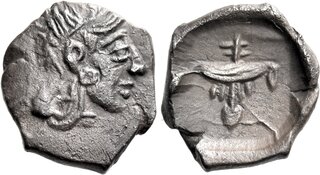Lot description:
Pharaonic Egypt, Nectanebo II, 359 – 340.
Tritartemorion circa 359-340, AR 10 mm, 0.65 g. Helmeted head of Athena r. Rev. Two hieroglyphs: collar with six beads (nub = gold), heart and windpipe (nefer = good).
Apparently unique and unpublished. An issue of tremendous importance and fascination
struck on a full flan and with a pleasant dark tone. Extremely fine
Besides the rare gold stater, two other series in silver and bronze are sometimes attributed to Nectanebo. A silver fraction, represented by two examples, one each in the collections of the British Museum and the American Numismatic Society, features a rough head of Athena on the obverse. This unique silver fraction is a very important piece as it proves that during his struggle to defend Egypt against the invading Persian forces of Artaxerxes III, Pharaoh Nectanebo II struck silver coins alongside his famous gold staters to pay his Greek mercenaries. Both coinages involve a curious intermingling of foreign and Egyptian elements. The very idea of struck coinage comes directly from the Greek conceptualisation of money, whereas coins were not a regular feature of the average native Egyptian's life in the fourth century BC. The weight standard for the gold issue appears to be that of the Persian daric-a recognised standard throughout the Greek world-while that of the silver tritetartemorion suggests that it is a fraction of the Persian siglos. On the obverse, the tritetartemorion features a head of Athena copied from contemporary Athenian tetradrachms, a widely recognised and frequently imitated coinage in the Near East of the fourth century BC. The reverse, however, is believed to represent two hieroglyphic signs: an Egyptian pectoral necklace crossed over a windpipe and heart which together are read as nwb nfr ("good gold"). The same symbols appear on Nectanebo's staters, which are indeed gold, but their presence on the new fraction is a little perplexing considering that it is made of silver. It is definitely a remarkable coin in need of greater study. In 404 BC, after decades of Persian rule, Egypt regained its independence under native pharaohs, but the Persian Great kings almost immediately began to launch invasions to reclaim the wealthy province. Failed Persian attacks were made in 385, 383 and 373 BC, but were repulsed thanks to the employment of Greek mercenaries and division in the Persian forces. Thus, when Nectanebo II ascended the throne of Egypt in 358 BC he knew very well that Egypt was overdue for a new Persian assault. Indeed, Nectanebo's assumption of power was partly due to the unsubtle preparations made by his predecessor Teos for the war that was certain to come. Teos was forced to the court of the Great King after overzealous taxing for the conflict caused the powerful Egyptian priestly class to rise up against him. In 351 BC, Artaxerxes III mounted the long-awaited invasion, but this was defeated by Nectanebo II and his Greek mercenary commanders, Diophantos of Athens and Lamios of Sparta. Evidently keen to export the revolution and chip away at nearby Persian authority, in 345/4 BC, the pharaoh also used 4,000 of the Greek mercenaries in his employ to support a Phoenician revolt led by the Sidonian king Tennes that had implications as far as Cyprus. This resulted in a major show of Persian force in 343 BC, which saw Idriaeus of Caria and an Athenian mercenary fleet reduce Cyprus to submission and a punitive campaign against Sidon led by the Great King himself. Sidon was taken by force and burned to the ground with its inhabitants while 600 of the leading men were crucified before the hapless city. Having inflicted this brutal punishment upon Sidon as a warning against future rebellion, Artaxerxes III made a new attempt to restore Persian authority over Egypt. With a grand army of 330,000 Persians and 14,000 Greek mercenaries, the Great King overwhelmed Nectanebo's much smaller force, although it included more Greeks. Artaxerxes III seized the Egyptian capital at Memphis and forced Nectanebo II to flee to Nubia. The land of the pharaohs had once again fallen to the Persians. However, Egypt chafed under restored Persian rule and Artaxerxes' intolerant religious policies so alienated the Egyptian priesthood that when Alexander the Great arrived a decade later, he was embraced by the Egyptians as a saviour. It was even rumoured by some that during his exile Nectanebo II had travelled to the Macedonian court of Philip II, where he had actually fathered Alexander in an illicit rendezvous with Philip's queen, Olympias.
Estimate: 12500 CHF |  |